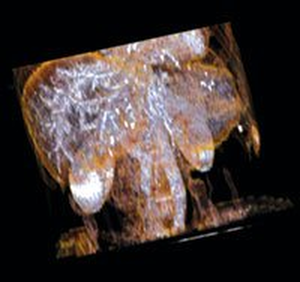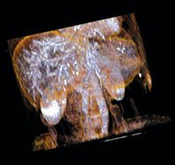Information
- Publication Type: Conference Paper
- Workgroup(s)/Project(s):
- Date: October 2003
- ISBN: 0780381203
- Publisher: IEEE
- Editor: G. Turk, J. van Wijk, K. Moorhead
- Booktitle: Proceedings of IEEE Visualization 2003
- Pages: 309 – 316
- Keywords: Hardware Acceleration, Segmentation, Non-linear Filtering
Abstract
Non-linear filtering is an important task for volume analysis. This paper presents hardware-based implementations of various nonlinear filters for volume smoothing with edge preservation. The Cg high-level shading language is used in combination with latest PC consumer graphics hardware. Filtering is divided into pervertex and per-fragment stages. In both stages we propose techniques to increase the filtering performance. The vertex program pre-computes texture coordinates in order to address all contributing input samples of the operator mask. Thus additional computations are avoided in the fragment program. The presented fragment programs preserve cache coherence, exploit 4D vector arithmetic, and internal fixed point arithmetic to increase performance. We show the applicability of non-linear filters as part of a GPU-based segmentation pipeline. The resulting binary mask is compressed and decompressed in the graphics memory on-the-fly.Additional Files and Images
Weblinks
No further information available.BibTeX
@inproceedings{Viola-2003-Har,
title = "Hardware-Based Nonlinear Filtering and Segmentation using
High-Level Shading Languages.",
author = "Ivan Viola and Armin Kanitsar and Eduard Gr\"{o}ller",
year = "2003",
abstract = "Non-linear filtering is an important task for volume
analysis. This paper presents hardware-based implementations
of various nonlinear filters for volume smoothing with edge
preservation. The Cg high-level shading language is used in
combination with latest PC consumer graphics hardware.
Filtering is divided into pervertex and per-fragment stages.
In both stages we propose techniques to increase the
filtering performance. The vertex program pre-computes
texture coordinates in order to address all contributing
input samples of the operator mask. Thus additional
computations are avoided in the fragment program. The
presented fragment programs preserve cache coherence,
exploit 4D vector arithmetic, and internal fixed point
arithmetic to increase performance. We show the
applicability of non-linear filters as part of a GPU-based
segmentation pipeline. The resulting binary mask is
compressed and decompressed in the graphics memory
on-the-fly.",
month = oct,
isbn = "0780381203",
publisher = "IEEE",
editor = "G. Turk, J. van Wijk, K. Moorhead",
booktitle = "Proceedings of IEEE Visualization 2003",
pages = "309--316",
keywords = "Hardware Acceleration, Segmentation, Non-linear Filtering",
URL = "https://www.cg.tuwien.ac.at/research/publications/2003/Viola-2003-Har/",
}


 Paper
Paper
